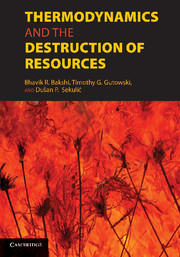Book contents
- Frontmatter
- Contents
- Contributor List
- Foreword by Herman E. Daly
- Foreword by Jan Szargut
- Preface
- Introduction
- PART I FOUNDATIONS
- 1 Thermodynamics: Generalized Available Energy and Availability or Exergy
- 2 Energy and Exergy: Does One Need Both Concepts for a Study of Resources Use?
- 3 Accounting for Resource Use by Thermodynamics
- PART II PRODUCTS AND PROCESSES
- PART III LIFE-CYCLE ASSESSMENTS AND METRICS
- PART IV ECONOMIC SYSTEMS, SOCIAL SYSTEMS, INDUSTRIAL SYSTEMS, AND ECOSYSTEMS
- Appendix: Standard Chemical Exergy
- Index
- References
1 - Thermodynamics: Generalized Available Energy and Availability or Exergy
Published online by Cambridge University Press: 01 June 2011
- Frontmatter
- Contents
- Contributor List
- Foreword by Herman E. Daly
- Foreword by Jan Szargut
- Preface
- Introduction
- PART I FOUNDATIONS
- 1 Thermodynamics: Generalized Available Energy and Availability or Exergy
- 2 Energy and Exergy: Does One Need Both Concepts for a Study of Resources Use?
- 3 Accounting for Resource Use by Thermodynamics
- PART II PRODUCTS AND PROCESSES
- PART III LIFE-CYCLE ASSESSMENTS AND METRICS
- PART IV ECONOMIC SYSTEMS, SOCIAL SYSTEMS, INDUSTRIAL SYSTEMS, AND ECOSYSTEMS
- Appendix: Standard Chemical Exergy
- Index
- References
Summary
Introduction
Ever since Clausius postulated that “the energy of the universe is constant” and “the entropy of the universe strives to attain a maximum value,” practically every scientist and engineer shares the beliefs that: (i) Thermodynamics is a statistical theory, restricted to phenomena in macroscopic systems in thermodynamic equilibrium states; and (ii) entropy – the concept that distinguishes thermodynamics from mechanics – is a statistical measure of ignorance, ultimate disorder, dispersion of energy, erasure of information, or other causes, and not an inherent property of matter like rest mass, energy, etc.
These beliefs stem from the conviction that the “known laws” of mechanics (classical or conventional quantum) are the ultimate laws of physics and from the fact that statistical theories of thermodynamics yield accurate and practical numerical results about thermodynamic equilibrium states.
Notwithstanding the conviction and excellent numerical successes, the almost-universal efforts to compel thermodynamics to conform to statistical and other nonphysical explanations, and to restrict it only to thermodynamic equilibrium states [1–3] are puzzling in the light of many accurate, reproducible, and nonstatistical experiences and many phenomena that cannot possibly be described in terms of thermodynamic equilibrium states.
Since the advent of thermodynamics, many academics and practitioners have questioned the clarity, unambiguity, and logical consistency of traditional expositions of the subject.
- Type
- Chapter
- Information
- Thermodynamics and the Destruction of Resources , pp. 15 - 44Publisher: Cambridge University PressPrint publication year: 2011
References
- 1
- Cited by



